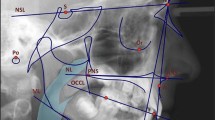Abstract
Background
Catathrenia is a rare sleep disorder characterized by repeated groaning in a protracted expiration preceded by a deep inspiration. This study aimed to explore whether anatomy is one of pathophysiology of catathrenia by investigating the anatomical features associated with catathrenia in the upper airway, craniofacial structures, and dental patterns.
Material and methods
Twenty-two patients with catathrenia (7 males, 15 females; age 22 to 69 years) were recruited as well as 66 patients matched by age and gender (matching proportion 1:3) with obstructive sleep apnea syndrome (OSAS). Both groups underwent cephalograms and dental casting, and cephalometric measurements and the Peer Assessment Rating (PAR) index was applied. Differences between the two groups were evaluated and cephalometric measurements in catathrenia group were compared with control values of Chinese patients from previous studies.
Results
As for airway-related measurements, increased PNS-R, PNS-UPW, and H-FH and decreased SPT and TGL were found in catathrenia group compared to normal values. Such trends were found even more evident when compared with the OSAS Group. As for craniofacial parameters, values of U1/NA and U1/SN were found increased in the catathrenia group compared with normal values and values of MP/FH and Y decreased. The differences were more distinct from the OSAS Group. Increased arch lengths and upper inter-first molar widths, and decreased overbite and PAR index, were found in catathrenia group compared with the OSAS Group.
Conclusion
Catathrenia patients present with a broad upper airway, yet protrusive upper incisors and flat mandibular angles. Anatomical characteristics of catathrenia are different from those associated with OSAS, namely a wide airway, large skeleton, and good occlusion.



Similar content being viewed by others
References
Guilleminault C, Hagen CC, Khaja AM et al (2008) Catathrenia: parasomnia or uncommon feature of sleep disordered breathing? Sleep 31(1):132–139
Vetrugno R, Provini F, Plazzi G et al (2001) Catathrenia (nocturnal groaning): a new type of parasomnia. Neurology 56(5):681–683
Abbasi AA, Morgenthaler TI, Slocumb NL et al (2012) Nocturnal moaning and groaning- catathrenia or nocturnal vocalizations. Sleep Breath 16(2):367–373
American Academy of Sleep Medicine (2005) The international classification of sleep disorders. Diagnostic and coding manual, 2nd ed. Westchester. pp 165–167
American Academy of Sleep Medicine (2014) The international classification of sleep disorders. Diagnostic and coding manual, 3rd ed. Darien p 141
Vetrugno R, Lugaresi E, Plazzi G et al (2007) Catathrenia (nocturnal groaning): an abnormal respiratory pattern during sleep. Eur J Neurol 14(11):1236–1243
Overland B, Akre H, Berdal H et al (2012) Sleep-related groaning: prevalence and characteristics in a cohort of patients with suspected obstructive sleep apnea. Acta Otolaryngol 132(1):90–95
Pevernagie DA, Boon PA, Mariman ANN et al (2001) Vocalization during episodes of prolonged expiration: a parasomnia related to REM sleep. Sleep Med 2(1):19–30
Iriarte J, Alegre M, Urrestarazu E et al (2006) Continuous positive airway pressure as treatment for catathrenia (nocturnal groaning). Neurology 66(4):609–610
American Academy of Sleep Medicine Task Force (1999) Sleep-related breathing disorders in adults: recommendations for syndrome definition and measurement techniques in clinical research. Sleep 22(5):667–689
Fu MK, Mao XJ (1965) Cephalometric analysis on 144 Chinese with normal occlusion. J Beijing Med Sch 4:251–256
Liu YH, Zeng XL, Fu MK, Huang XZ (1997) X-ray cephalometry study of normal people's upper airway structure orthodontics. Chin J Orthod 4(1):10–14
Fu M, Lin J, Xu T et al (2009) edit. Orthodontics. Peking University Medical Press, Beijing, pp 63–64
Richmond S, Shaw WC, O'Brien KD et al (1992) The development of the PAR Index (Peer Assessment Rating): reliability and validity. Eur J Orthod 14(2):125–139
Ott SR, Hamacher J, Seifert E (2011) Bringing light to the sirens of night: laryngoscopy in catathrenia during sleep. Eur Respir J 37(5):1288–1289
De Roek J, Van Hoof E, Cluydts R (1983) Sleep-related expiratory groaning. A case report. J Sleep Res 12:237
Acknowledgment
The subject was partly supported by the National Natural Science Foundation of China (81470272), and the Seeding Grant for Medicine and Engineering Sciences of Peking University (BMU20140397).
Conflict interest
We declare that there is no commercial or associative interest that presents conflict with the work submitted.
Author information
Authors and Affiliations
Corresponding authors
Additional information
Zeliang Hao and Liyue Xu contributed equally to this work.
Rights and permissions
About this article
Cite this article
Hao, Z., Xu, L., Zhang, J. et al. Anatomical characteristics of catathrenia (nocturnal groaning) in upper airway and orofacial structures. Sleep Breath 20, 103–111 (2016). https://doi.org/10.1007/s11325-015-1191-1
Received:
Revised:
Accepted:
Published:
Issue Date:
DOI: https://doi.org/10.1007/s11325-015-1191-1



